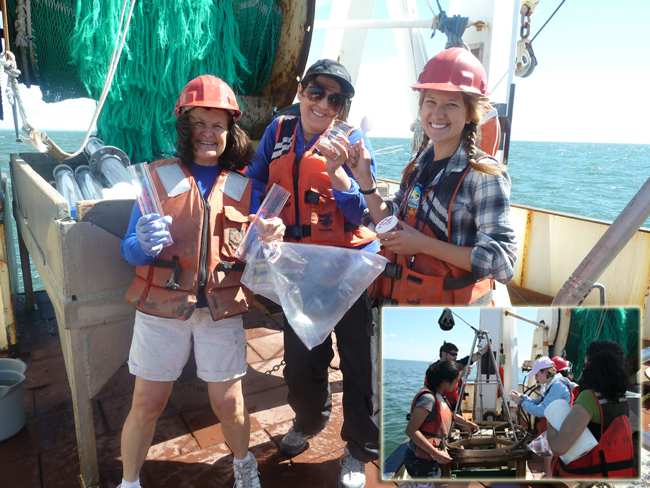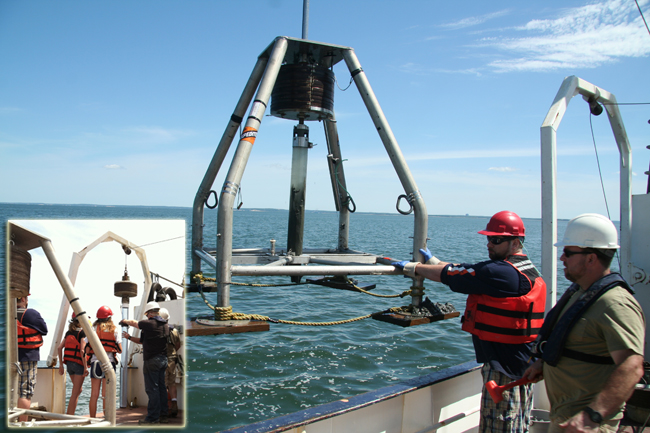Sea Grant Programs and US EPA Long Island Sound Study To Fund Two-Year Water Quality Studies
Contacts:
Barbara Branca, Communications Manager, New York Sea Grant, E: barbara.branca@stonybrook.edu, P: 631-632-6956
Peg Van Patten, Communications, Connecticut Sea Grant, E: peg.vanpatten@uconn.edu, P: 860-405-9141
Robert Burg, EPA Long Island Sound Office, E: rburg@longislandsoundstudy.net, P: 203-977-1546

Adjunct Senior Research Scientist Cecilia McHugh and students are ready for the next sediment sample Credit: Elissa Olivera. INSET: Students sampling a sediment grab. Credit: Frank Nitsche, Lamont-Doherty Earth Observatory of Columbia University
Stony Brook, NY, April 1, 2015 - The Sea Grant programs of Connecticut and New York announced today that they will fund research grants that will aim to illuminate the changing conditions that cause hypoxia (low oxygen conditions) in Long Island Sound. The research is supported by the bi-state Long Island Sound Study with funding from the US Environmental Protection Agency.
The three projects, totaling $843,424, involve teams of researchers in two states. Using different techniques and asking different but related questions, the researchers will examine nutrient cycling and the impacts of nitrogen pollution on water quality in Long Island Sound. This research will improve our ability to model future conditions and management actions. Projects began in March 2015 and should be completed in 2017.
“By focusing our research efforts on understanding how the ecosystem is responding to reductions in nitrogen loading, we will be able to more accurately predict how the system might respond to future changes and what steps might be necessary to achieve long term goals for water quality in the Sound,” said Mark Tedesco, director of the EPA Long Island Sound Office.
Craig R. Tobias, University of Connecticut Department of Marine Sciences, will examine biogeochemical processes involving nitrogen loss and recycling in Long Island Sound sediments and the connections to overlying waters. The result will help researchers and managers gauge the susceptibility of the Sound to changes in nitrogen loads and how the system might respond to recent or future decreases in nitrogen.
Robinson “Wally” Fulweiler, Boston University Department of Earth and Environment, will quantify changes in organic matter as it at falls through the water to the sediment in five locations. She will also examine how the movement of nutrients into and out of the sediment may be changing in response to changes in the magnitude of nutrient inputs. Bacterial processes in the sediments can augment or mask changes in the nutrient concentration of the overlying water by storing or releasing nitrogen from the sediments, and these relationships can vary with changes in temperature, sediment type, and nitrogen concentration.
Mark A. Altabet, UMass Dartmouth Department of Estuarine and Ocean Science, will use isotope geochemical techniques to examine the impact of recent changes in nitrogen inputs and oxygen levels due to recent upgrades to wastewater treatment plants. Stable isotopes allow scientists to identify the sources of nitrogen (e.g. sewage, fertilizers, air emissions) and evaluate the importance of recycling and other bacterial processes to the overall nitrogen budget of LIS.

Retrieval of USGS hydraulically damped gravity corer with sediment. Credit: Frank Nitsche, Lamont-Doherty Earth Observatory of Columbia University. INSET: Preparing the gravity sediment corer for deployment. Credit: Mary McElroy
More Info:
The Long Island Sound Study Research Grant Program
The Long Island Sound Study Research Grant Program is conducted by Connecticut Sea Grant, based at the University of Connecticut at Avery Point, and New York Sea Grant, based at Stony Brook University. Both are part of the National Sea Grant College Program network, administered by the National Oceanic and Atmospheric Administration (NOAA). Sea Grant’s mission is to foster the conservation and rational use of our coastal and marine resources through research, outreach and education. Funding for the program is provided to the NOAA Sea Grant programs by EPA as part of the Long Island Sound Study, a cooperative effort between the EPA and the states of Connecticut and New York to restore and protect the Sound and its ecosystems.
Long Island Sound / Long Island Sound Study
Long Island Sound is one of the 28 nationally-designated estuaries under
the NEP, which was established by Congress in 1987 to improve the
quality of Long Island Sound and other places where rivers meet the sea.
The Long Island Sound Study, conducted under the Environmental
Protection Agency’s (EPA) National Estuary Program (NEP), is a
cooperative effort between the EPA and the states of Connecticut and New
York to restore and protect the Sound and its ecosystems. For more on what you can do to make a difference, click over to the "Get Involved" or "Stewardship" sections of the Long Island Sound Study's Web site. News on the Long Island Sound Study can also be found in New York Sea Grant's related archives. If you would like to receive Long Island Sound Study's newsletter, please visit their site's homepage and sign up for the "e-news/print newsletter" under the "Stay Connected" box. For daily updates and tips on how you can help protect and restore Long Island Sound, please join LISS on Facebook or, sign up for their RSS feeds.
New York Sea Grant
New York Sea Grant (NYSG), a cooperative program of Cornell University
and the State University of New York, is one of 33 university-based
programs under the National Sea Grant College Program (NSGCP) of the
National Oceanic and Atmospheric Administration (NOAA). The NSGCP
engages this network of the nation’s top universities in conducting
scientific research, education, training and extension projects designed
to foster science-based decisions about the use and conservation of our
aquatic resources. Through its statewide network of integrated
services, NYSG has been promoting coastal vitality, environmental
sustainability, and citizen awareness about the State’s marine and Great
Lakes resources since 1971.
For updates on Sea Grant activities: www.nyseagrant.org has RSS, Facebook, Twitter, and YouTube links. NYSG also offers a free e-list sign up via www.nyseagrant.org/coastlines for its flagship publication, NY Coastlines/Currents, which is published several times a year.